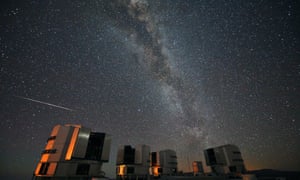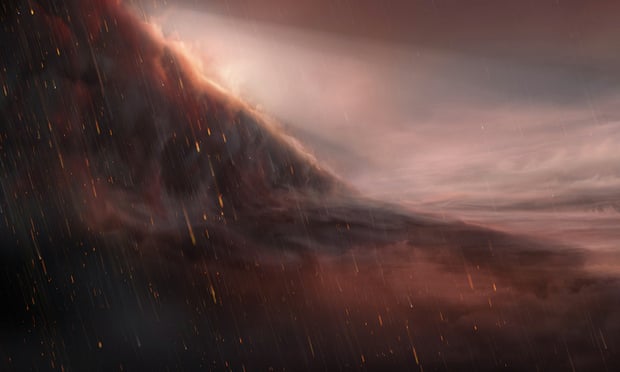Conditions on Wasp-76b in Pisces include temperatures of 2,400C and 10,000mph winds
Source: The Guardian
Wasp-76b is what astronomers call an exoplanet, one that orbits a star outside our solar system. Scientists have discovered that the local weather conditions include 2,400C temperatures, winds in excess of 10,000mph and a steady pelting of iron rain.
The observations of the distant planet’s unusually hostile climate are the first results from a new instrument on the Very Large Telescope in Chile, which astronomers say will transform our view of worlds far from beyond our own solar system.
Wasp-76b, which is 640 light years away in the constellation of Pisces, is an ultra-hot gas giant. It orbits its star at about 3% of the distance between the Earth and the Sun, resulting in scorching surface temperatures and the weird phenomenon of molten iron falling from the sky.
“It’s a kind of world we can’t imagine easily because we don’t have anything like that in our solar system,” said Christophe Lovis, an exoplanet researcher at the University of Geneva and co-author of the paper.
Because the planet is so close in, it is “tidally locked” (like the Moon’s orbit about Earth) and only only ever shows one face, its day side, to its parent star, while its cooler night side remains in perpetual darkness.

On the day side, which is 1,000 degrees hotter, molecules separate into atoms, and iron evaporates into the atmosphere to form metallic clouds. The extreme temperature difference between the day and night sides produces ferocious winds that carry the iron vapour to the cooler night side, where temperatures decrease to about 1,500C and the iron condenses and falls as rain that constantly peppers the planet’s gas surface and vanishes beneath it.
“One could say that this planet gets rainy in the evening, except it rains iron,” said David Ehrenreich, a professor at the University of Geneva in Switzerland and lead author.
The observations came from a new instrument, the Echelle Spectrograph for Rocky Exoplanets and Stable Spectroscopic Observations (Espresso) that was originally designed to hunt for Earth-like planets around Sun-like stars. It does this by spotting the dip in starlight that occurs as a planet sails across the face of the star.
For giant planets that are very close to their home star, detecting these transits is an easier task as they block out more light. Scientists have now moved on to more refined observations that look not only at the dip in intensity but how the spectrum of the light is shifted, which can reveal what gases are present in the planet’s atmosphere.
The latest observations go one step further still and compare the gases present in the leading edge of the planet as it passes across the face of the star and the trailing edge.
For Wasp-76b, this revealed iron vapour at the leading edge, where the prevailing 10,000mph wind would be blowing from the day side into the night side. But the signal was absent from the trailing edge, suggesting that all the iron had rained down on the night side by the time the circulating wind came back around.
The findings, published in the journal Nature, are the latest to give new insights into the enormous diversity of planets beyond our own solar system. More than 4,000 exoplanets have now been confirmed and powerful new ground-based observatories under construction, such as the Extremely Large Telescope, and the James Webb Space Telescope, scheduled to launch next year, are expected to bring astronomers closer to answering whether any of these have the necessary conditions to support extraterrestrial life.
Source: The Guardian

































Leave a Comment
You must be logged in to post a comment.